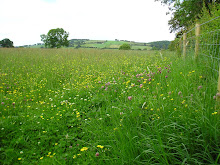

Swarming is the bees' method of creating new colonies. Its a problem for beekeepers because the interruption reduces the honey harvest. So the scene was set for this season's battle of wits. We prepared carefully. We have two colonies to deal with. In order to swarm there must be three elements present: a Queen, young brood with nurse bees, and plenty of foraging bees. The trick is to separate out one of these elements and arrangements had been made for this to be done on the 20th April at 2.30pm. Paul, a fellow beekeeper even newer to the craft than us, was invited to come to watch the process. At 1.45pm on taking the necessary equipment down the garden to the apiary an ominous roar was heard from the Sycamore hedge - yes the little b......s had beaten us to it by 45 minutes. There they were clustered in the hedge. Last year they went one day before the nominated time. Either they have supernatural powers, can read emails, or just saw us coming. So Paul arrived to find that the curriculum had changed from swarm control to swarm collection. Fortunately the swarm ahd chosen an accessable branch from which they were easily knocked into a blue plastic box. Then they were poured onto a ramp covered with a white cloth leading into a hastily assembled hive. They obligingly marched into their new home. Next day an inspection of the original colonies revealed queen cells in number 2 so this was where tghe swarm had come from. Swarm prevention was carried out on hive 1 and the queen cells removed from number 2. The swarm in its new hive (3) was placed where 2 had been to collect the foraging bees and strengthen numbers. The original 2 was moved to one side and the queen cells removed. Three of them were put in a box and left in the bee shed while we enjoyed a cup of tea. On checking the box a hour later amazed and delighted to see that one queen had emerged. She was introduced to the queenless hive 2 and we wait to see how she gets on. Fellow beekeeper Hamish had lost two queens recently so rang him and offered the remaining two queen cells. Next day took the box up to him nad on opening it found that another queen had emerged. He has introduced her to one of his colonies and inserted the remaining queen cell into the other - fingers crossed. Next inspection now due 29th April.






